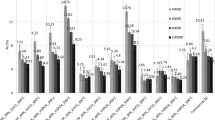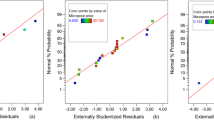Abstract
Aerobic granulation can be regarded as a microorganism-to-microorganism self-immobilization process, in which cell hydrophobicity could be a decisive parameter in determining the microorganism-to-microorganism interaction and structural compactness of aerobic granules. This study looked into the thermodynamic interpretation of cell hydrophobicity in aerobic granulation; and a model that correlates microbial interaction and relative cell hydrophobicity defined as the ratio of cell hydrophobicity over cell hydrophilicity was derived. This model describes how cell hydrophobic and hydrophilic interactions affect aerobic granulation and offers deep insights into the thermodynamic mechanisms of microbial aggregation. The model prediction was in good agreement with experimental data. Results showed that aerobic granulation was a function of cell hydrophobicity over cell hydrophilicity, i.e. a high cell hydrophobicity strongly favors microbial aggregation and results in a more compact structure.







Similar content being viewed by others
References
Alves M, Cavaleiro AJ, Ferreira EC, Amaral AL, Mota M, Morra M da, Vivier H, Pons MN (2000) Characterization by image analysis of anaerobic sludge under shock conditions. Water Sci Technol 41:207–214
APHA (1998) Standard methods for the examination of water and wastewater, 19th edn. American Public Health Association, Washington, D.C.
Beun JJ, Hendriks A, Loosdrecht MCM van, Morgenroth E, Wilderer PA, Heijnen JJ (1999) Aerobic granulation in a sequencing batch reactor. Water Res 33:2283–2290
Bos R, Mei HC van de, Busscher HJ (1999) Physico-chemistry of initial microbial adhesive interactions—its mechanisms and methods for study. FEMS Microbiol Rev 23:179–230
Bossier P, Verstraete W (1996) Triggers for microbial aggregation in activated sludge. Appl Microbiol Biotechnol 45:1–6
Chen G, Strevett KA (2003) Impact of carbon and nitrogen conditions on E. coli surface thermodynamics. Colloid Surf B Biointerfer 28:135–146
Del Re B, Sgorbati B, Miglioli M, Palenzona D (2000) Adhesion, autoaggregation and hydrophobicity of 13 strains of Bifidobacterium longum. Lett Appl Microbiol 31:438–442
Kjelleberg S, Hermansson M, Marden P, Jones GW (1987) The transient phase between growth and nongrowth of heterotrophic bacteria, with emphasis on the marine environment. Annu Rev Microbiol 41:25–49
Kos B, Suskovic J, Vukovic S, Simpraga M, Frece J, Matosic S (2003) Adhesion and aggregation ability of probiotic strain Lactobacillus acidophilus M92. J Appl Microbiol 94:981–987
Kwok WK, Picioreanu C, Ong SL, Loosdrecht MCM van, Ng WJ, Heijnen JJ (1998) Influence of biomass production and detachment forces on biofilm structures in a biofilm airlift suspension reactor. Biotechnol Bioeng 58:400–407
Lettinga G, Velsen AFM van, Hobma SW, Zeeuw W de, Klapwijk A (1980) Use of the upflow sludge blanket (USB) reactor concept for biological waste water treatment especially for anaerobic treatment. Biotechnol Bioeng 22:699–734
Liao BQ, Allen DG, Droppo IG, Leppard GG, Liss SN (2001) Surface properties of sludge and their role in bioflocculation and settleability. Water Res 35:339–350
Lin YM, Liu Y, Tay JH (2003) Development and characteristics of P-accumulating microbial granules in sequencing batch reactors. Appl Microbiol Biotechnol 62:430–435
Liu QS (2003) Aerobic granulation in sequencing batch reactor. PhD thesis, Nanyang Technological University, Singapore
Liu Y, Yang SF, Liu QS, Tay JH (2003a) The role of cell hydrophobicity in the formation of aerobic granules. Curr Microbiol 46:270–274
Liu Y, Xu H, Yang SF, Tay JH (2003b) A general model for biosorption of Cd2+, Cu2+ and Zn2+ by aerobic granules. J Biotechnol 102:233–239
Moy BYP, Tay JH, Toh SK, Liu Y, Tay STL (2002) High organic loading influences the physical characteristics of aerobic granules. Lett Appl Microbiol 34:407–412
Ochoa JC, Colprim J, Palacios B, Paul E, Chatellier P (2002) Active heterotrophic and autotrophic biomass distribution between fixed and suspended systems in a hybrid biological reactor. Water Sci Technol 46:397–404
Olofsson AC, Zita A, Hermansson M (1998) Floc stability and adhesion of green-fluorescent-protein-marked bacteria to flocs in activated sludge. Microbiology 144:519–528
Peng D, Bernet N, Delgenes JP, Moletta R (1999) Aerobic granular sludge—a case study. Water Res 33:890–893
Qin L (2003) Optimizing operation conditions for enhanced aerobic granulation in sequencing batch reactor. PhD interim report, Nanyang Technological University, Singapore
Qin L, Tay JH, Liu Y (2003) Selection pressure is a driving force of aerobic granulation in sequencing batch reactors. Process Biochem DOI 10.1016/S0032-9592(03)00125-0
Quarmby J, Forster CF (1995) An examination of the structure of UASB granules. Water Res 29:2449–2454
Roels JA (1983) Energetics and kinetics in biotechnology. Elsevier, New York
Rosenberg M, Gutnick D, Rosenberg E (1980) Adherence of bacteria to hydrocarbons: a simple method for measuring cell surface hydrophobicity. FEMS Microbiol Lett 9:29–33
Ryoo DH, Choi CS (1999) Surface thermodynamics of pellet formation in Aspergillus niger. Biotechnol Lett 21:97–100
Sharma PK, Rao KH (2003) Adhesion of Paenibacillus polymyxa on chalcopyrite and pyrite: surface thermodynamics and extended DLVO theory. Colloid Surf B Biointerfer 29:21–38
Tay JH, Liu QS, Liu Y (2001) Microscopic observation of aerobic granulation in sequential aerobic sludge reactor. J Appl Microbiol 91:168–175
Tijhuis L, Loosdrecht MCM van, Heijnen JJ (1995) Dynamics of biofilm detachment. Biotechnol Bioeng 45:481–487
Van Oss CJ, Good RJ, Chaudhury MK (1986) The role of van der Waals forces and hydrogen bonds in hydrophobic interaction between biopolymers and low energy surface. J Colloid Interface Sci 111:378–390
Zita A, Hermansson M (1997) Effects of bacterial cell surface structures and hydrophobicity on attachment to activated sludge flocs. Appl Environ Microbiol 63:1168–1170
Acknowledgement
We thank Mrs. Xu Hui for her help in model simulation.
Author information
Authors and Affiliations
Corresponding author
Rights and permissions
About this article
Cite this article
Liu, Y., Yang, SF., Qin, L. et al. A thermodynamic interpretation of cell hydrophobicity in aerobic granulation. Appl Microbiol Biotechnol 64, 410–415 (2004). https://doi.org/10.1007/s00253-003-1462-9
Received:
Revised:
Accepted:
Published:
Issue Date:
DOI: https://doi.org/10.1007/s00253-003-1462-9




